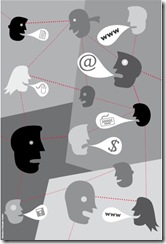With a recession on the cards, there is no better time than now for enterprises to harness the value of Web 2.0 in their business by capturing innovation, collaboration and social engagement, asserts Brian Armstrong, BT’s general manager for Turkey, Middle East and Africa
 Not so long ago, Web 2.0 was the new kid on the consumer technology block, and people were excitedly speculating about its potential in business. Right now, the economic climate makes excited speculation about the potential of anything a pretty rare commodity. There is an argument, however, that a downturn or recession is precisely the climate in which Web 2.0 tools will prove their worth. The key question to examine is what hidden value they can liberate from organisations during a downturn. We believe that Web 2.0 provides a route to business efficiency – and therein lies its potential as a key to unlock value.
Not so long ago, Web 2.0 was the new kid on the consumer technology block, and people were excitedly speculating about its potential in business. Right now, the economic climate makes excited speculation about the potential of anything a pretty rare commodity. There is an argument, however, that a downturn or recession is precisely the climate in which Web 2.0 tools will prove their worth. The key question to examine is what hidden value they can liberate from organisations during a downturn. We believe that Web 2.0 provides a route to business efficiency – and therein lies its potential as a key to unlock value.
In contrast to traditional enterprise software, which requires ICT infrastructure prior to use, this generation of software tends to encourage use prior to providing structure. Specific social software tools that have been adapted for enterprise use already include: unstructured search tools; wikis; weblogs for storytelling; social bookmarking for tagging and building organisational folksonomies; RSS for signalling; collaborative planning software for peerbased project planning and management; social networking tools; mashups for visualisation; and even prediction markets for forecasting and identifying risks.
The next impact to affect organisations is likely to be found in the capture and use of the sort of information that Web 2.0 excels at generating. Social networking works because people like to share information. The capabilities of related software
to share and foster collaboration can help organisations distil meaningful, re-usable knowledge about customers and products, captured in tools such as blogs, online communities, and wikis. Companies are beginning to introduce online community pages to their products, to enable customers of one service or product to find others with the knowledge they may need. A similar process in the enterprise, with workers sharing information about projects across territories or perhaps between organisations, will help drive global collaboration.
Blogs and wikis are, at the heart, collaboration tools. As such, they are powerful at sharing unstructured information associated with ad hoc or ongoing projects and processes. The unstructured information provided by social technologies is particularly useful in business processes that are not rigidly pre-defined, but where people work together in an adaptive way to innovate solutions where speed and creativity are of the essence. The pressure on businesses in the current environment is putting speed and results far ahead of processes designed for a more comfortable era.
Business IT applications will start to mirror the features found in popular consumer social software, such as Facebook and MySpace, as organisations look to improve employee collaboration and harness the community feedback of customers.
 Traditional business models have focused on a hierarchical model, which has not changed for more than 100 years, which proposes ‘good ideas’ come from leaders at the top of the organisation. This model does not make the most of the knowledge and experiences of each and every individual within the organisation.
Traditional business models have focused on a hierarchical model, which has not changed for more than 100 years, which proposes ‘good ideas’ come from leaders at the top of the organisation. This model does not make the most of the knowledge and experiences of each and every individual within the organisation.
However, with the injection of some fundamental Web 2.0 technologies such as social networks, businesses can finally tap into the knowledge of all their employees, partners, and customers. Web 2.0 will help differentiate companies from competitors who continue to rely on advertising and other traditional methods of communicating with their customers. We are just at the beginning of this as a communication tool. Customer relationship management (CRM) for example, is essentially about how to treat different customers differently. There is no tool more promising than social applications to start making those connections more personal and effective – from both a customer service and a cost perspective – than Web 2.0.
That said, companies should avoid using Web 2.0 simply in an effort to keep up with competitors. It is crucial to have clarity on the purpose of such tools and the value they can provide for both customers and the company, before deploying them.
There is a need for Web 2.0 business tools to work well together in order to make them as effective as the tools we use at home – instant messaging, Facebook or Skype, for example – but this is largely an awareness issue on the part of CIOs, who need advice on the benefits of integrating these tools into the business.
Ultimately, the point that Web 2.0 tools are innately simple to use is a good one – the obstacle to business adoption is a lack of awareness among the user community about the value of using them in a workplace setting. You get version control, speed, simplicity and a quantum improvement in security by forcing the community to use just one document. The myriad of copies across servers, PCs and email inboxes is a huge drain on resources and a major headache for the information security team.
The efficiency benefit in just this one example is clear. Is there more hidden value to be unlocked? Yes. Before using application sharing tools, thoughts or ideas about how a document or presentation or financial model, for example, could be made better would be ‘water cooler conversations’, and consequently be lost. With Web 2.0, those valuable conversations – the collaborative sharing of ideas – can happen in cyberspace, which means you can capture it.
Recessions, historically, have been periods that force companies to think innovatively and creatively about how to stand out. As with customer service, if ‘ideas’ are to be a differentiator, there is no better set of tools than Web 2.0 to serve businesses right now. Cost-effective to implement, simple to use and conducive to innovation, better customer service and less duplication – sounds like a recession is a golden opportunity for the value of business Web 2.0 to be unlocked.





0 comments ↓
There are no comments yet...Kick things off by filling out the form below.
Leave a Comment